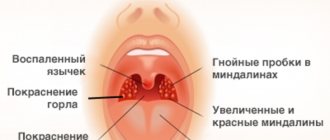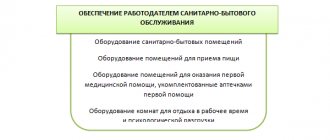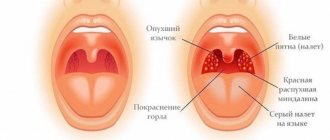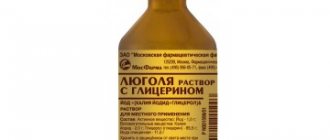Author:
- Elena Vitalievna Naumova, otolaryngologist, leading doctor of the clinic
2.82 (Votes: 11)
Acute tonsillitis with purulent exudate is considered the most common infection.
The disease occurs in both adults and children due to the entry of pathogenic microbes and bacteria into the oral cavity. It is not difficult to get a purulent sore throat even in the absence of direct contact with a sick person. Bacteria are spread through contact and airborne transmission, such as by sneezing or coughing in a public place or sharing household items.
Forms of purulent sore throat
There are two varieties:
- Purulent sore throat, affecting the lacunae of the tonsils. The infection is localized in the upper part of the throat and does not penetrate deeper. Purulent deposits are easily separated with a spatula.
- Purulent tonsillitis affecting the lymph nodes. The infection penetrates deeper and affects the lymphoid apparatus. Purulent exudate cannot be separated manually. The condition is extremely serious and threatens the formation of a peritonsillar abscess. Urgent medical attention and hospitalization are required.
Prevention
By paying attention to preventive measures, you can reduce the risk of developing the disease. Effective prevention includes:
- avoiding hypothermia (wearing warm clothes, monitoring microclimatic indicators in the room);
- regular preventative visits to the dentist to identify the early stages of caries and stomatitis;
- giving up bad habits (smoking, drinking alcohol);
- moderate physical activity, regular walks in the fresh air;
- normalization of diet, sleep and wakefulness;
- compliance with hygiene standards and requirements, maintaining cleanliness in the home and workplace;
- limiting contacts with unfamiliar people during periods of unfavorable epidemiological conditions.
Strengthening the immune system based on leading a healthy lifestyle helps to avoid infection and make it easier to endure purulent sore throat.
If you have a sore throat, call us and we will definitely help you!
Causes of sore throat (acute tonsillitis)
The accumulation of purulent “sacs” in the tonsils occurs for various reasons. The main causative agents of tonsillitis are streptococci, but viral and fungal pathogens, staphylococci and pneumococci are also found. If the body is healthy, then the infection will not develop, but the following factors can aggravate the condition:
- Injuries to the tonsils and nasopharynx.
- Weak immunity.
- Chronic diseases of the ear, nose and throat, for example, stomatitis, caries, rhinitis, etc. foci of infection increase the proliferation of pathogens.
- Local and general hypothermia, for example, eating ice cream or drinking cold water.
- Autumn-spring vitamin deficiency.
The pathogenic factor penetrates deep into the tissues of the tonsils, forming a focus of infection.
Important!
A deadly disease called “diphtheria” at the initial stage can masquerade as a sore throat. Therefore, it is better to play it safe and take a throat swab, which will determine the presence of Loeffler’s bacillus (diphtheria bacillus). This must be done even if you are vaccinated against diphtheria - the vaccine does not provide 100% protection, although it significantly reduces the likelihood of developing a severe form of the disease. A smear helps not only to remove the diagnosis of diphtheria, but also to identify the causative agent of sore throat.
Clinical picture
Once a pathogen enters the body, two hours are enough for it to spread. Streptococci settle on the tonsils, weakening local immunity. The incubation period varies from several hours to 5 days.
The main differences between purulent tonsillitis are symptoms:
- A sharp pain in the throat occurs, which causes discomfort even at rest. The next day she becomes unbearable when talking or eating.
- Within a few hours, the body temperature rises to 39-40°C. Against the background of high temperature, it throws you either hot or cold, sweating increases and chills are present.
- Swallowing saliva causes severe, sharp pain.
- There is not enough air when breathing due to swelling of the tonsils.
- When examined with the naked eye, swollen tonsils and severe hyperemia of the back wall of the throat are visible. The next day the tongue and palate swell.
- There is a sensation of a foreign body in the nasopharynx, which intensifies when saliva is swabbed.
- Due to the fact that the tonsils are well supplied with blood, a yellowish-white dot appears on them, the boundaries of which quickly expand. The next day, the throat may become covered with many white purulent dots, which gradually merge into large ulcers.
Purulent tonsillitis in children occurs in a more severe form. Due to the excessive pressure of the swollen lymphoid tissue of the adenoids on the Eustachian tubes, the ears become blocked and there is tinnitus. If treatment is not attempted, the infection can spread to the ears, complicated by otitis media.
Usually the acute period lasts no more than one week if treatment is prescribed on time.
Important to know and remember! Purulent tonsillitis is a dangerous infectious disease, so the patient should be immediately isolated from household members.
Why are tonsils needed?
The tonsils are an integral part of our immune system. And their main purpose is to protect the body from the penetration of pathogenic bacteria and viruses. In total, a person has six of them: palatine and tubal (paired), pharyngeal and lingual. By their names you can roughly understand in which part of the pharynx they are located. Their general arrangement resembles a ring. This ring acts as a kind of barrier for bacteria. When we talk about inflammation of the tonsils, we mean only the palatine tonsils (aka tonsils). Let's look at them in more detail.
If you open your mouth wide, then in the mirror you can easily see two formations that look like almonds - tonsils, these are tonsils. Each tonsil consists of small openings (lacunae) and winding canals (crypts).
Bacteria that enter the air, in contact with the tonsils, are rebuffed and are immediately disposed of, without having time to cause an outbreak of a particular disease. Normally, a healthy person does not even suspect that real fighting is taking place inside him. Now you understand the importance of the mission of the palatine tonsils. Therefore, a good otolaryngologist will never rush to recommend their removal. Although to hear from a doctor, speaking about tonsils: “They need to be removed!” - a common phenomenon in our time. Unfortunately, today not all clinics can offer high-quality treatment for tonsillitis, and sometimes the turnaround rate is off the charts. That is why it is sometimes easier for a doctor to brush it off and refer the patient for surgery.
Treatment of purulent sore throat
Purulent tonsillitis threatens serious complications from the heart, kidneys, joints and soft tissues of the neck if therapy is chosen incorrectly or treatment is started late. It is for this reason that it is important to immediately consult a doctor when the first signs of a sore throat appear.
The basic treatment regimen for acute tonsillitis with purulent exudate:
- Taking antibiotics of the penicillin group or the macrolide group. You can't do without them. General and local remedies are prescribed. Antibiotics kill pathogenic microflora and after a few days the production of pus stops, blood circulation in the tonsils is restored.
- Taking anti-inflammatory lozenges, lozenges, lozenges.
- Gargling and irrigating the throat with different solutions every hour.
- Use of local antiseptics in the form of a spray.
- Taking antipyretic drugs.
- Vitamin therapy and taking immunomodulators.
The principle of treatment of acute tonsillitis in children is similar, the only differences are in the dosage of medications. The patient needs to observe strict bed rest, talk less and gargle more often.
If the prescribed drug therapy does not have positive dynamics within several days, the patient continues treatment in the hospital.
Due to the presence of purulent plaque on the palatine tonsils, eating is difficult or completely impossible, so you can eat only pureed and liquid food, and also drink a lot of warm water to relieve symptoms of intoxication.
Classification B.S. Preobrazhensky
| Form of the inflammatory process | Distinctive manifestations |
| Simple (uncomplicated) form | Only local signs are present: Pus and dense plugs from it, closing the lumen of the lacunae, and the inflamed surface of the tonsils (they are loose, red, swollen). Inflamed edges of the arches of the palate (they are swollen, red, infiltrated). |
| Toxic-allergic tonsillitis 1st degree | Local manifestations of an uncomplicated form are superimposed by general symptoms of an allergic-toxic nature: Periodic low-grade fever (temperature readings up to 37.5°C). Tonsillogenic intoxication, present constantly or periodically - decreased performance, fatigue, poor appetite, general weakness, malaise, feeling of weakness throughout the body. Enlargement of the lymph nodes of the neck, their soreness. Periodically appearing joint pain. Changes in blood tests - increased leukocytes, accelerated ESR. |
| Toxic-allergic tonsillitis 2nd degree | Signs of the 1st degree are accompanied by severe manifestations of a toxic-allergic nature: Functional ECG changes. Heart pain. Heart rhythm disturbances. Long-lasting low-grade fever. Development of autoimmune complications of tonsillitis. |
Prohibited methods of treatment for purulent sore throat
Unfortunately, patients often make independent treatment attempts, which only worsen the clinical picture. The following actions are prohibited:
- Pierce the ulcers with sharp objects.
- Push out, tear off or squeeze out ulcers.
- Treat tonsils with hydrogen peroxide, Lugol's solution, iodine.
- Warm your throat and gargle with hot water.
- Rinse with vinegar and concentrated alcohol solution.
- Apply compresses of vodka and alcohol to the throat.
Important to remember! It is very dangerous to try to remove purulent deposits on your own.
At the ENT CLINIC in Chertanovo, otolaryngologists immediately help patients. They carry out non-contact removal of purulent plaque using ultrasound on the CAVITAR device (USOL therapy). Pharyngoscopy and smear analysis are performed to determine sensitivity to antibiotics in order to prescribe an effective medicine. Specialists use modern drugs of the latest generation to improve the patient’s condition. Based on the severity of the disease, individual characteristics, and age of the patient, the clinic’s ENT doctor prescribes medications and gives recommendations for treating purulent tonsillitis at home.
Washing the tonsils.
The procedure for washing the tonsils has a great positive effect, as a result of which pus is released from the lacunae and the medicine is administered. There are several ways to carry out the procedure.
The oldest, so to speak, ancient method is sanitation with a syringe. It is used quite rarely due to its low efficiency and traumatic nature, compared to the advent of more modern methods. The syringe is used when the patient has a strong gag reflex or very loose tonsils.
In other cases, a more effective method is used - vacuum rinsing with a special attachment of the Tonzillor apparatus.
But it is not without its drawbacks:
- the container into which the purulent contents of the tonsils are “pumped out” is opaque, and the doctor cannot see whether the rinsing is complete;
- The design feature of the nozzle is such that when the pressure necessary for complete rinsing is reached, the nozzle can injure the tonsils.
Our clinic for the treatment of tonsillitis offers its patients an alternative painless option for washing the tonsils using the improved “Tonsillor” nozzle - this is the “know-how” of our clinic. There are no analogues of our nozzle in other medical institutions in Moscow. It eliminates the disadvantages of a conventional nozzle: the rinsing container, which is suctioned to the tonsil, has transparent walls, and the otorhinolaryngologist can see what “comes out” of the tonsils. This eliminates unnecessary manipulations. The nozzle itself is non-traumatic and can be used even by children of school age.











